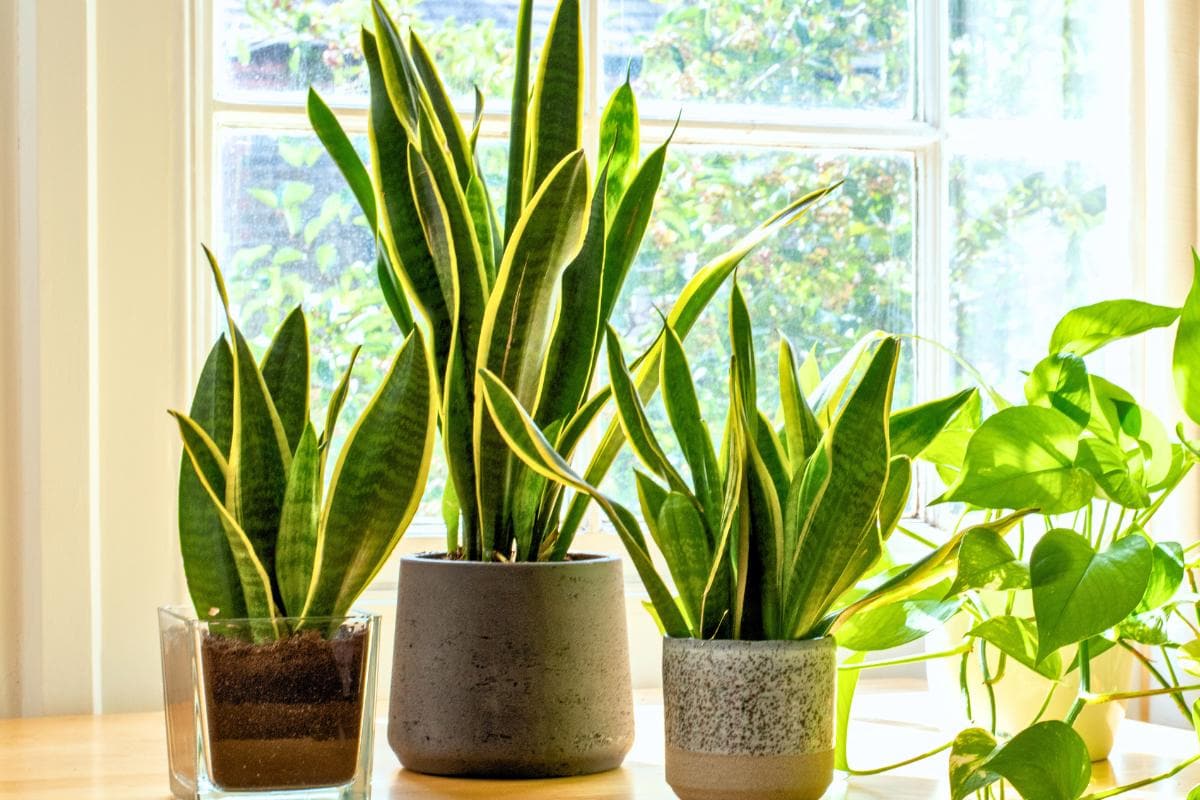Want to grow more snake plants without spending a dime? This guide will teach you exactly how to propagate snake plant using simple leaf cuttings in water or soil, no green thumb required.
Whether you’re working with Sansevieria trifasciata or another variety of snake plant, propagation is surprisingly easy. With just one healthy leaf, you can grow multiple new plants and expand your indoor jungle for free.
Ready to start propagating snake plant like a pro? Let’s walk through the best methods step-by-step.

Can You Propagate Snake Plant from a Leaf?
Yes, you can propagate a snake plant from a leaf, it’s one of the easiest and most beginner-friendly ways to multiply your Sansevieria. Simply cut a healthy leaf into sections, let them callus for 1–2 days, then place the cuttings in water or soil until roots begin to form.
Keep in mind: if you’re propagating a variegated snake plant, the new plants may not retain their patterns. But overall, leaf propagation is reliable, low-risk, and a great way to grow more plants for free.
👉 Want your new plants to thrive after propagation? Check out my snake plant care guide for tips on lighting, watering, and long-term growth.
Methods for Propagating Snake Plants
How to Propagate Snake Plant in Water
Water propagation is one of the easiest and most popular methods to multiply your snake plant. It’s beginner-friendly, low-maintenance, and allows you to watch root development as it happens.
Start by selecting a healthy leaf and cutting it near the base using sharp, sterilized scissors or a knife. Let the cut leaf sit for 1–2 days so a callus can form, this step is essential to prevent rot when the leaf is submerged in water.
Once the leaf has callused, place it upright in a clear glass or jar filled with room-temperature water. Only the bottom inch of the cutting should be submerged. Be sure to position the leaf with the correct end down (the original base of the leaf), as reversing it will prevent rooting.
Set your container in a bright, indirect light location, and change the water once a week to keep it fresh and bacteria-free. Within 3–6 weeks, you should begin to see white roots forming at the base of the cutting.
Once roots are about 1–2 inches long, you can transfer your propagated snake plant into soil, or leave it in water longer if you prefer hydroponic growth.
How to Propagate Snake Plant in Soil
Soil propagation is a great option if you want your new snake plant cuttings to establish roots directly in their final growing medium. It skips the transplant stage and mimics how snake plants grow in nature.
Start by selecting a healthy, mature leaf from the base of the plant. Use a sharp, sanitized knife or scissors to make a clean cut, and allow the cutting to callus over for 1–2 days. This helps protect against rot and encourages root formation once it’s in the soil.
Once the callus has formed, gently insert the cut end into a small pot filled with well-draining soil. Snake plants thrive in loose, aerated soil, so use a mix of potting soil blended with perlite, coarse sand, or cactus mix to improve drainage and oxygen flow.
Firm the soil gently around the base of the cutting to keep it stable, but avoid planting it too deep. Place the pot in a warm location with bright, indirect light, and lightly water the soil. Keep it slightly moist but never soggy, overwatering is the most common reason for failure.
In 4–6 weeks, roots should begin developing beneath the surface. Once new leaves start to emerge, you’ll know your soil-propagated snake plant is officially growing strong.

Preparing to Propagate a Snake Plant
Before you start cutting leaves, make sure your snake plant (Sansevieria trifasciata) is healthy and well-established. Successful propagation starts with a strong parent plant and the right conditions.
Timing matters: The best time to propagate snake plants is during their active growing season, typically in spring and summer. Warmer temperatures and increased light help stimulate faster root development, giving your cuttings a better chance of success.
Tools Needed for Snake Plant Propagation
Gather your materials before you begin. Having the right tools on hand will reduce plant stress and improve your success rate.
- Sharp, sterilized scissors or pruning shears
- Small pots with drainage holes
- Clean water (for water propagation)
- Well-draining potting mix (for soil propagation)
- Labels (optional, for tracking variegation types)
Avoid dull or dirty tools, as they can damage your plant and introduce bacteria.
How to Choose Healthy Leaves for Propagation
Selecting the right leaf is one of the most important steps in snake plant propagation. Choose a firm, mature leaf with no signs of damage, yellowing, or disease. Leaves near the base of the plant are usually the strongest and most likely to root successfully.
If your snake plant has variegation, keep in mind that leaf propagation often results in new plants without those same patterns, especially if you’re using only a section of the leaf. For best results, propagate from the base of a fully grown variegated leaf and note that results may vary.

Is It Better to Propagate Snake Plant in Water or Soil?
When it comes to propagating snake plant, both water and soil methods are effective—but each has its own pros and cons. Your choice depends on your experience level, preference, and how much hands-on care you want to provide.
Below is a side-by-side breakdown of water propagation vs. soil propagation to help you decide which method is best for your plant propagation goals.
Water Propagation: Pros & Cons
✅ Pros:
- Allows you to visually monitor root development, which is ideal for beginners or curious plant parents.
- Reduces the risk of overwatering early on, no soil means fewer drainage issues.
- Clean and low-mess, great for small spaces or desks.
⚠️ Cons:
- Roots grown in water may struggle to adjust once transplanted to soil.
- Delicate transition process can damage new roots if handled roughly.
- Growth may be slower compared to soil-based rooting.

Soil Propagation: Pros & Cons
✅ Pros:
- Mimics the plant’s natural growing conditions, encouraging faster root establishment.
- No need to transplant them later, cuttings stay in the same container.
- Often results in stronger, more resilient root systems from the start.
⚠️ Cons:
- Requires careful watering and well-draining soil to avoid rot.
- Root development happens below the surface, so progress isn’t visible.
- Slightly more effort to monitor moisture and conditions early on.
Final Verdict: Water or Soil Propagation?
If you enjoy watching root progress and want a low-commitment approach, propagating snake plant in water might be for you. If you’re focused on efficiency and long-term success, soil propagation gives your cuttings a head start in their final growing environment.
Whichever method you choose, make sure to:
- Select a healthy leaf from the base of the plant
- Use sterilized cutting tools
- Allow the cutting to callus properly
- Provide bright, indirect light and minimal disturbance
With the right care, both methods will reward you with new, healthy snake plants to add to your collection.
Water vs. Soil Propagation for Snake Plants
| Feature | Water Propagation | Soil Propagation |
|---|---|---|
| Visibility of Root Growth | ✅ Roots are visible as they grow | ❌ Roots are hidden below the soil |
| Ease for Beginners | ✅ Great for observing the process | ⚠️ Requires monitoring moisture levels |
| Risk of Transplant Shock | ⚠️ High – roots may struggle when moved to soil | ✅ Low – roots develop in final medium |
| Mess/Setup | ✅ Clean and simple (just a jar of water) | ⚠️ Soil can be messy and needs drainage |
| Root Strength | ⚠️ Weaker roots may form in water | ✅ Typically results in stronger roots |
| Growth Speed | ⚠️ Slower – roots adapt after transplant | ✅ Often faster – direct establishment in soil |
| Best For | Beginners, visual learners, small spaces | Efficient growers, long-term plant health, fewer transitions |
Caring for Newly Propagated Snake Plants
Now that you’ve successfully propagated your snake plant from a leaf cutting, it’s time to help your new plants thrive. The first few weeks are critical for establishing healthy roots and encouraging new leaf growth.
Follow these essential care tips to give your propagated Sansevieria the best possible start.

Light Requirements for Snake Plant Cuttings
Newly propagated snake plants do best in bright, indirect light. Avoid placing them in direct sun, especially during midday, as this can scorch tender leaves. While snake plants can survive in low light, optimal growth happens when they receive plenty of filtered sunlight.
Ideal locations include:
- East- or north-facing windows
- Bright rooms with sheer curtains
- Well-lit shelves or corners away from harsh sunbeams

Watering Your Propagated Snake Plants
When it comes to watering, less is more. Overwatering is the most common mistake with snake plant care, especially during propagation.
Tips to avoid root rot:
- Let the soil dry completely between waterings
- Use pots with drainage holes to prevent water buildup
- Water deeply, but infrequently
- Use distilled or filtered water to prevent mineral accumulation
If propagating in water, change the water weekly to keep bacteria at bay and encourage clean root growth.
Monitoring Growth After Propagation
Your new snake plant may take several weeks to show visible signs of growth. This is normal, Sansevieria are slow growers, especially after propagation.
What to watch for:
- New leaves emerging from the base
- Thicker, white roots growing in soil or water
- A firm, upright stance in the pot (a sign that roots are anchoring)
Be patient, and avoid disturbing the cuttings too often. With consistent care and the right environment, your new plants will gradually transform into healthy, independent snake plants.

Snake Plant Care Guides
How Fast Does a Snake Plant Grow?
Common Snake Plant Diseases & Remedies
Best Fertilizer for Snake Plant
How Much Water Does a Snake Plant Need?
Did you enjoy this guide sharing how to propagate snake plants? Sign up for the free newsletter and follow along on Pinterest, so you never miss another gardening post again.
As an avid gardener, dedicated homemaker, and culinary enthusiast, I bring a wealth of knowledge and passion to every aspect of homemaking, recipes, travel, and gardening. My journey is deeply rooted in a love for nature, food, and exploration, which I share through my engaging content.
With years of experience cultivating a vibrant garden and crafting delicious recipes, I specialize in creating farm-to-table homestyle dishes that highlight the freshest ingredients. My culinary creations are inspired by my extensive travels, allowing me to infuse a variety of flavors from my travels into my kitchen.
Through my blog, I aim to inspire others with practical gardening tips, mouth-watering recipes, and unique travel experiences. Whether you're looking for garden-to-plate cooking ideas, copycat recipes, or advice on homemaking, I provide a trusted source of information and inspiration.
Join me as I blend the joys of gardening, cooking, and travel into a harmonious lifestyle, offering readers a well-rounded perspective on how to bring these passions into their own homes.

